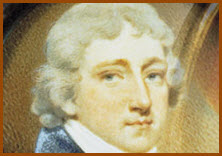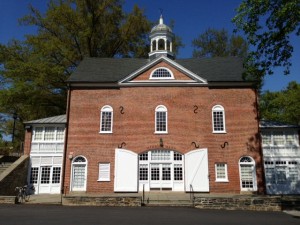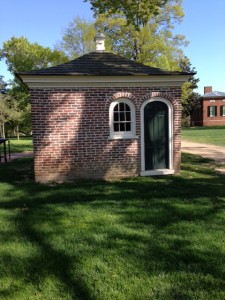 Charles Carroll, Jr. of Homewood (1775-1825), like many gentlemen of his time, was caught up in the excitement of current horticultural developments. He experimented with new varieties of plants, grafted roses, designed vegetable gardens, and planted an orchard at Homewood. In an 1801 letter to his wife, he describes an unfortunate incident in the orchard:
Charles Carroll, Jr. of Homewood (1775-1825), like many gentlemen of his time, was caught up in the excitement of current horticultural developments. He experimented with new varieties of plants, grafted roses, designed vegetable gardens, and planted an orchard at Homewood. In an 1801 letter to his wife, he describes an unfortunate incident in the orchard:
I am sorry to tell you that my blundering gardner [sic] has suffered the cow to get into the orchard and nip off the tops of almost all the trees – the cow (which is a little pranky at times) I mean to have butchered in the morning. (March 1801, letter to Harriet, private collection)
On an early spring day before the family moved to Homewood for the summer, Charles Carroll, Jr. might have ridden from his Baltimore townhouse to enjoy a stroll around his property. The trees would have leafed out, and flowers would be in bloom. Many years later in an 1819 rental advertisement for Homewood, Charles extols his property as follows:
The grounds, which are well watered, are handsomely bordered by wood, and the lawns have been carefully planted with groves and Clumps of forest trees. Besides a variety of the choicest fruits in prime bearing, there are two gardens suitable to the growth of early and late vegetables. In point of salubrity and rural scenery few situations are superior. (Federal Gazette, Baltimore Daily Advertizer, March 13, 1819.)
To imagine this landscape, walk around the campus to see what Charles might have seen. Although only 3 buildings survive from 1801, and the landscape has been seriously altered, one can imagine what might have been. Begin at the privy, which is very fancy with its brickwork and trim. Inside there are 2 compartments – one for males and one for females – and is paneled with chestnut. During this period there might have been fragrant plants around the privy. Pleasure gardens were probably planted behind Homewood, and the vegetable gardens may have been to the west where a farmhouse was located. The orchards occupied land near the dorms and across what is now Charles Street.
 Continue your walk past the library and look at the stable/barn. This building, like Homewood House, is constructed of brick with Palladian windows, although these are Gothic in style. The only change in this structure was made to the front and lower doors, which were originally wood, not glass. Today it is called the Merrick Barn and is the home of the Undergraduate Program in Theatre Arts and Studies.
Continue your walk past the library and look at the stable/barn. This building, like Homewood House, is constructed of brick with Palladian windows, although these are Gothic in style. The only change in this structure was made to the front and lower doors, which were originally wood, not glass. Today it is called the Merrick Barn and is the home of the Undergraduate Program in Theatre Arts and Studies.
 At this point the landscape begins to change; it becomes more hilly. When you arrive at the Baltimore Museum of Art’s sculpture garden, you will see what some of the Homewood property looked like – quite different from the upper parts of campus. In addition, there was no Charles Street or Art Museum Drive, and the roads that existed were at a much lower elevation. This is a perfect place to sit for a while – enjoy the garden, smell the flowers, and let your mind wander back in time.
At this point the landscape begins to change; it becomes more hilly. When you arrive at the Baltimore Museum of Art’s sculpture garden, you will see what some of the Homewood property looked like – quite different from the upper parts of campus. In addition, there was no Charles Street or Art Museum Drive, and the roads that existed were at a much lower elevation. This is a perfect place to sit for a while – enjoy the garden, smell the flowers, and let your mind wander back in time.
If you want a longer walk that includes other points of interest such as the Mattin Center and the Baltimore Museum of Art, go the Homewood Museum website to learn about the Historic Homewood ArtWalk or download the podcast to explore the landscape on your own.

